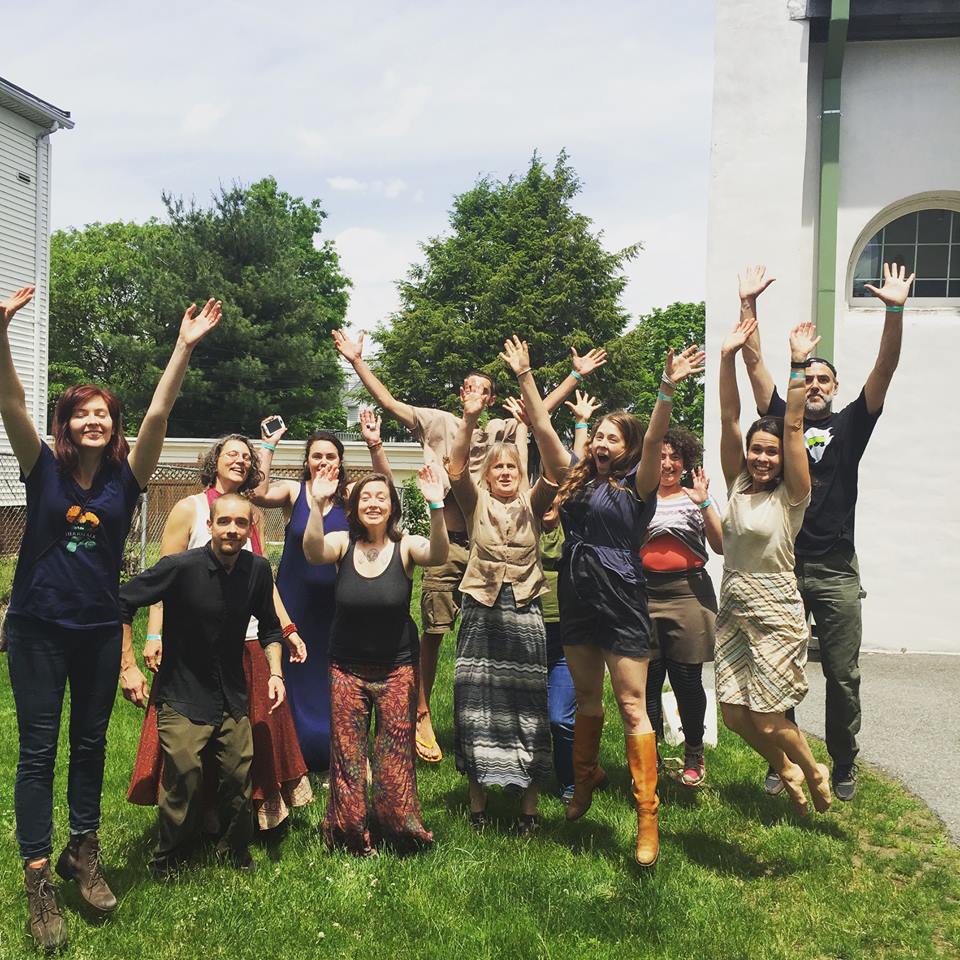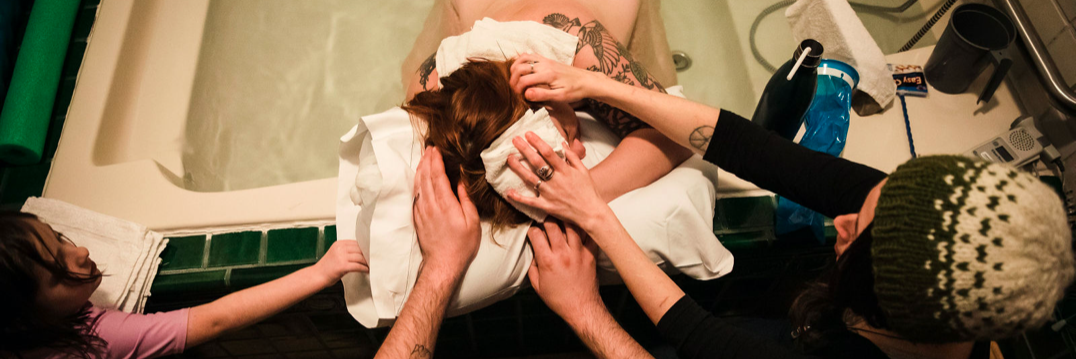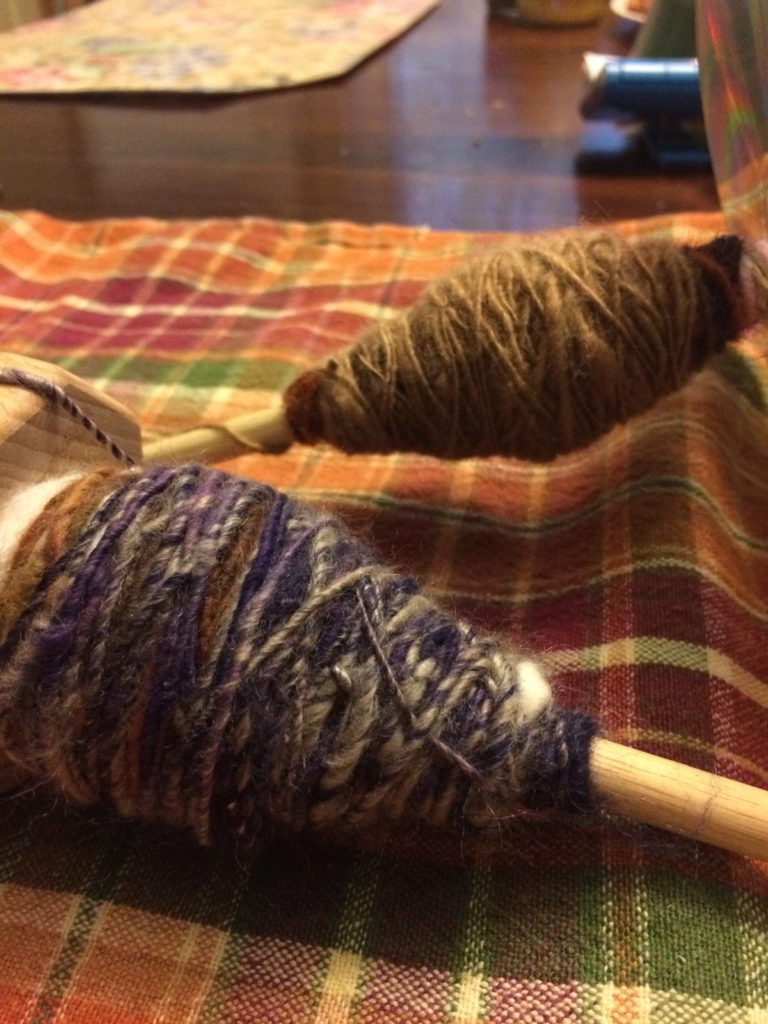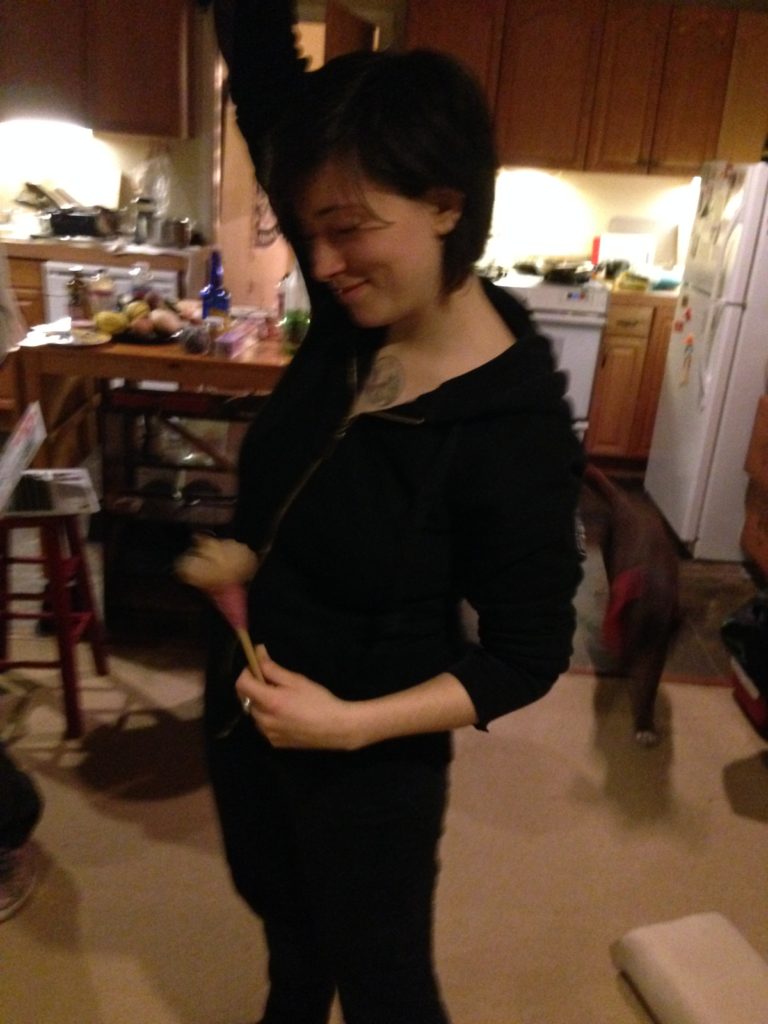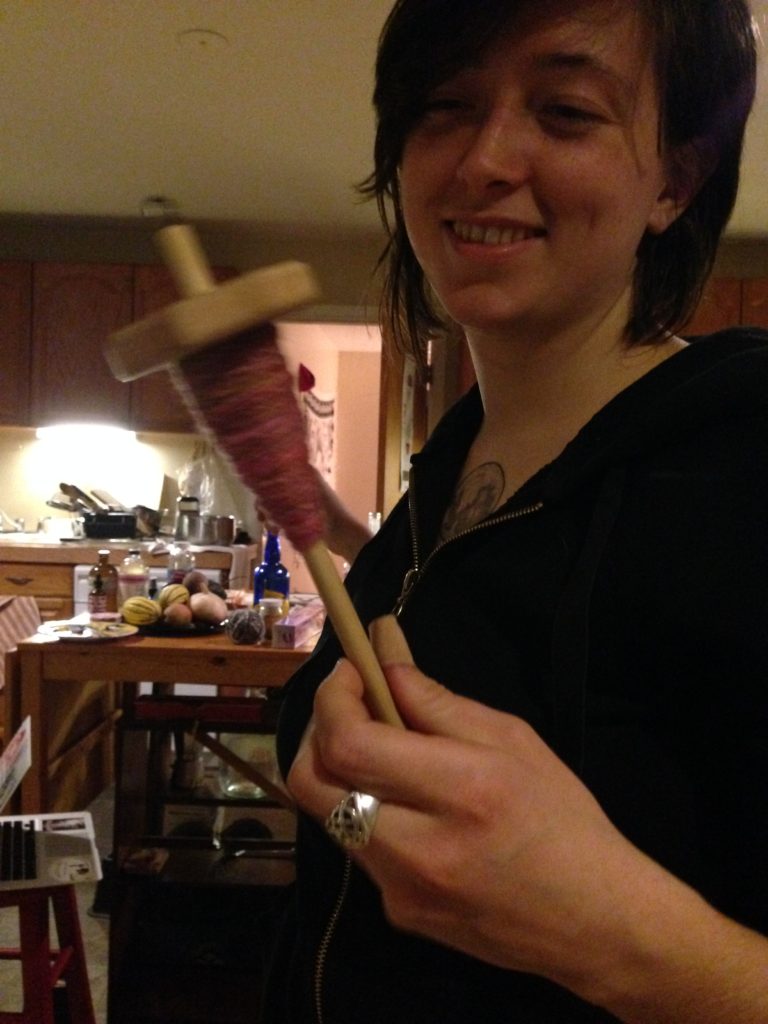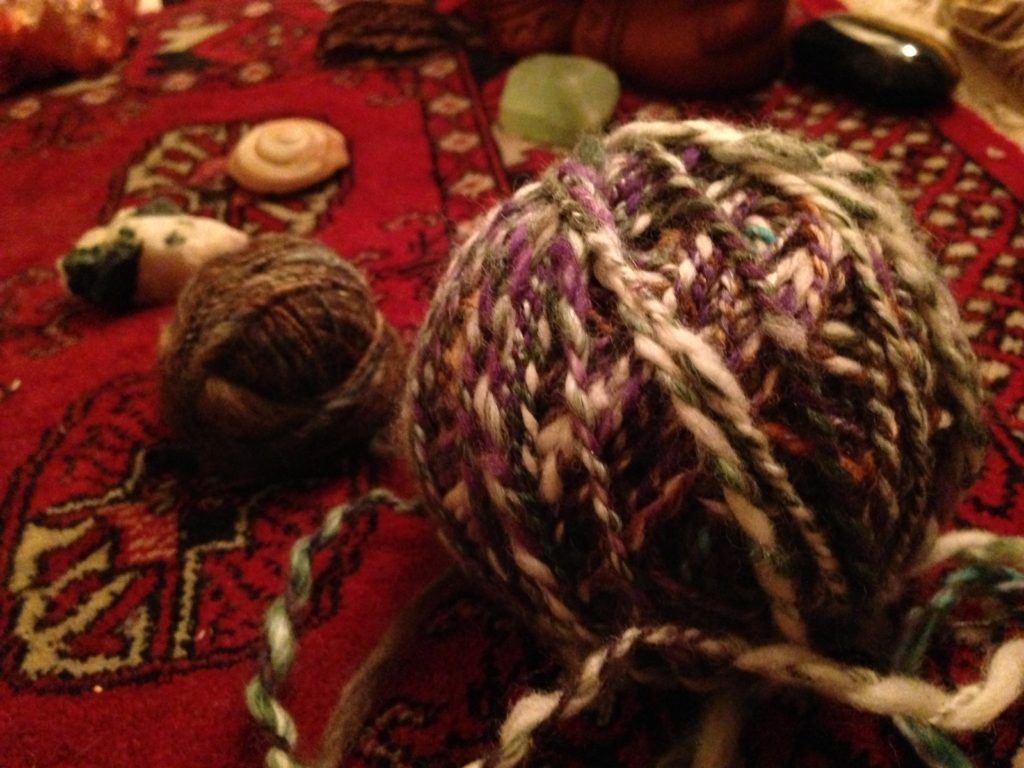Herbstalk 2017 will be happening again at the Somerville Armory on June 3rd and 4th. Along with many other herbalists, I will be teaching a class at the event about herbal allies for pregnancy loss. Keep an eye out for the schedule falling into place, and I’ll see you at Herbstalk!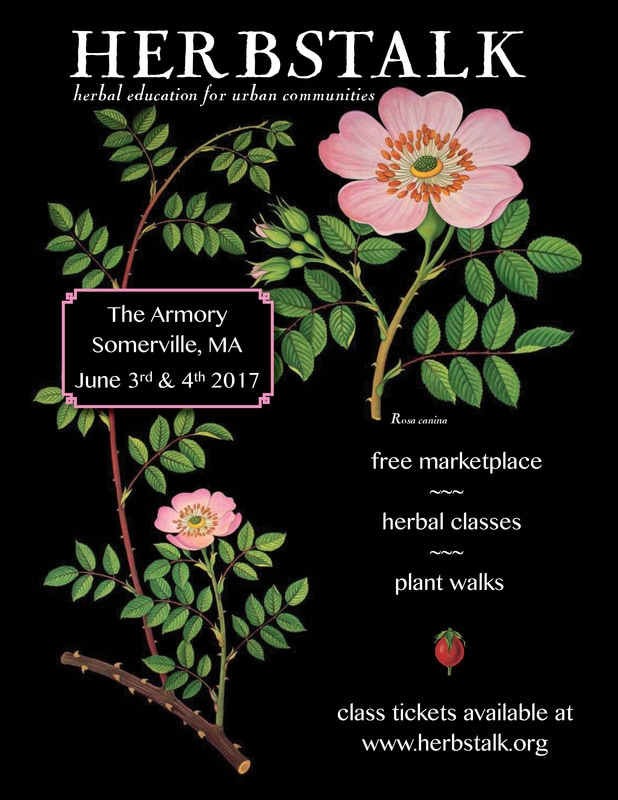
Interview with an Acupuncturist
Last week, I had the pleasure of making a little video interview with local acupuncturist, Angela Bell. She often works with folks who are trying to conceive (including with IVF and other fertility treatments), as well as during pregnancy and generally focuses her practice on women’s health. More about her practice can be found on her Facebook and website.
One thing I so adore about Angela is her desire to connect and highlight others who are birth workers in the Boston area. She holds networking events, and has continued to host a video series on her social media pages for other birth workers to highlight their work. She’s chatted with doulas, massage therapists, midwives, yoga instructors, lactation consultants and others about the work we all do with clients.
In our 30 minute interview, we cover what it means to be a “full-spectrum” doula. I talk about why I decided to become a doula, the work I do with the Boston Doula Project, how others doing this work can best support LGBTQ+ families. We also chat about placenta encapsulation, my practice in Western herbal medicine and what it means to be an advocate for folks in all of this work. If you’re interested to get to know me a little better, check out this video interview!
The Business of Being a Doula
A few folks in my life have recently asked how I feel about the divisive/controversial ProDoula articles that are circulating. Honestly, as someone who chooses not to use any social media, I probably would have missed this entirely if folks didn’t bring it to my attention. I was relatively preoccupied while attending two clients’ 37-week labors, organizing the year’s goals with the steering committee of the Boston Doula Project, and encapsulating another client’s placenta.
Generally, I think there is enough space in Boston (I can’t speak for smaller or more rural communities) for many types of doula practices and their clients. While some doulas have always argued that providing free or very low-cost services devalues doula work as a profession, others continue to provide free or very low-cost services because it is exactly what they are called to do. I absolutely believe folks need to charge a rate for their work that is sustainable to them. On-call support for labor is extremely valuable, and not just because the studies show doulas save thousands of dollars in healthcare costs. We literally prevent trauma (and hold space for trauma that exists) on a regular basis.
The ProDoula founder is right to say that plumbers don’t worry about people who can’t afford to hire plumbers, but birth is not the same as home repairs. Supporting one another in the childbearing year is something that people have always done, and are always going to do. We live in a time and place in human history where folks aren’t all having 15 babies, witnessing 10 younger siblings be born, hanging out around groups who are feeding babies at their chests, and having that community of support built in. We’re giving birth in hospitals, often in big cities far away from family. Most often, the first birth people witness is their own baby’s! We’re needing to pay people out of pocket to create a sense of that lost community support. This used to be culturally built-in, for everyone, for free.
I’m all for folks charging what they need to in order to make their work sustainable – that part’s important and isn’t typically emphasized in many doula trainings. Most doula trainings emphasize what’s normal in birth and postpartum, what’s not, how to be a compassionate and competent helper and how to plug into the extended community of resources for when you need to make referrals. These articles make it sound like ProDoula’s trainings emphasize profits, avoiding the local community (“ProDoula tells doulas to ignore local doula collectives — why fraternize with the competition?”) ostracizing new doulas, and not making referrals because your agency provides The Best And Only care.
- Kara Schamell, at Modern Mama Midwifery has tons of experience, especially in sanitation techniques and lab safety as a midwife. We back up each other’s placenta clients in the case of travel or client birth overlap.
- Jennifer Lynn Frye, at New England Placenta Encapsulation, who has a background in nursing, and has been providing this service since 2014. She was also part of the first-ever batch of Boston Doula Project trainees.
- Jennifer Lewis, at New Life Blessings has encapsulated over 250 placentas in MA, RI and CT.
Placenta Encapsulation FAQ
Here are the answers to some frequently asked questions I receive about placenta encapsulation.
Why would anyone want to eat their placenta? I get this a lot. Usually, I start here: all mammals consume the placenta immediately following the birth, with a few exceptions. These exceptions include whales (who have baleen and generally don’t/can’t eat large pieces of meat), and alpaca-family animals (such as camels). When I asked an alpaca farmer at an agricultural fair why they don’t ingest their placentas, she quickly responded “Their tongues aren’t long enough!” Many domesticated/farm animals have humans who interfere with the postpartum process before they instinctively ingest the placenta. The third exception is humans. While there are a few theories as to why this is, many people are now choosing to consume the placenta in capsule form postpartum. In some circles, it isn’t very popular to consume organ meats, but many folks know they’re some of the most nutrient-dense foods in the world. The placenta contains iron, minerals, high-quality protein as well as hormones (oxytocin, progesterone) that sustained the pregnancy and labor. This helps build parents back up after blood loss, especially if it was more than average. Anecdotally, folks who choose to consume their placenta after birth have fewer bouts of hormone-crashing lows, a strong milk supply, and a little more sustained energy throughout all the sleep depravation.
How many capsules does it yield? Average is about 80-100 capsules. I’ve processed placentas with as few as 53 capsules (when some pieces were saved for Pathology) and as many as 165 capsules. Generally speaking, I’ve found bigger babies have bigger placentas.
How does pickup and drop off work? I’m happy to meet you at your place of birth between 8am and 9pm to pick up your placenta. With some advance notice that you’re in labor (either from you or a partner or doula), I may be able to arrive for pickup quicker. As long as the placenta is kept on ice within two hours after the birth, we should be all set for processing. Processing takes 2-3 days, on my end, and I am happy to return the finished capsules to you when you return home from the hospital.
What if I have medications during labor, or need a cesarian section? That is fine! The medications used during labor generally pass through the placenta or break down quickly. If you had an allergic reaction to any medication given during labor, I would not recommend encapsulation. With a cesarian birth, it is extra important to make sure the placenta is put on ice soon afterward, because everyone tends to be a little busier during that time than with a vaginal birth!
What if I am Group B Strep positive? Group B Strep (GBS) is a normal digestional bacteria that some folks have a high concentration of in the genital area during pregnancy and birth. It is not considered harmful to adult humans (just in rare cases for babies), and I generally recommend steaming the placenta before dehydration for folks who are GBS+.
What if there was meconium in labor? Meconium happens! It is sterile and not harmful to adults. Extra nurses will be present at your birth to check out the baby’s lungs and make sure your baby did not aspirate the sticky meconium. Otherwise, meconium washes off the placenta easily during processing and does not contraindicate placenta encapsulation. If there is prolonged exposure to thick meconium, the placenta may look “stained” upon delivery and providers may want to send it to pathology to have it looked at, but that is much less common.
What if my baby is premature? With premature birth, many hospitals will want to send the placenta to pathology to make sure that it wasn’t the cause of a premature birth. In this case, you can advocate for the placenta being kept refrigerated, frozen and chemical-free. The pathologist should be able to remove a few small pieces from the placenta and leave the rest for you to take home, if no problems are found. Keep in mind that hospital pathologists work M-F, 9-5, so this can delay the process, depending on the time you give birth. With any placenta that has been to pathology (even if it is kept separate), I recommend steamed preparation.
How does my birth site impact my decision to keep my placenta for encapsulation? Great question! I always recommend folks talk with their providers about keeping the placenta ahead of time, just to make sure there are no issues. Every birth site (except for homes) will require you sign a placenta release form after the birth before it is able to leave. Certain hospitals have policies that may further impact your experience. For example, Brigham and Women’s Hospital’s policy is to keep the placenta in the hospital until the family and baby are released. They keep it refrigerated for you, but this will delay my ability to process by a few days. Beth Israel Hospital does not let anyone bring the placenta into the postpartum room with them. This means, if you’re hoping to keep your placenta and you’ve given birth in the middle of the night, you need to keep it in a cooler in your car (or have another family member pick it up and bring it to a refrigerator) until I am able to pick it up. Cambridge Birth Center generally releases patients within 6-8 hours after the birth. If you give birth at the birth center, and it is late at night, I may be able to pick up the placenta in the morning from your home. If you have particular questions about the placenta-related policies at your birth site, be sure to ask your provider.
What about payment? My fee for placenta encapsulation is $250. Cash or check are welcome. The fee is due at the time I deliver the finished capsules. In the off chance that you are unable to keep the placenta, I do not require a downpayment.
More to come..!!
Consumer Reports: Your Biggest C-Section Risk May Be Your Hospital
While the World Health Organization states that the ideal rate for necessary cesarian births should be around 10-15% (with more recent studies showing that rates above 10% do not decrease mortality rates for parents or for babies), the US Office of Disease Prevention and Health Promotion (Department of Health and Human Services) sets our goal at 23.9%. Since this goal was set (as 10% lower than the average in 2007), approximately 60% of hospitals in the United States do not yet meet this goal.
Another doula and I were chatting about experiences at a local hospital where a client of mine awaited a planned cesarian for a suspected big baby. This doula mentioned that the birth site we were discussing was on the top of a list of local hospitals who perform medically unnecessary cesarian sections. She shared with me the consumer report on cesarian rates for low-risk babies. The report does not include cesarian statistics from anyone who has a prior cesarian, is carrying more than one baby, or who has a baby in anything but a head-down position. This data also doesn’t include anyone with a chronic health condition, heart problems, high blood pressure or obesity. Truly, this is a thorough compilation of comparative unnecessary cesarian rates, state-by-state.
Some takeaways about Boston-area birth sites:
The lowest cesarian section rates come from:
- Cambridge Health Alliance (which includes Cambridge Birth Center and Cambridge Hospital)
- Mount Auburn (don’t think any Boston-area birth worker is surprised about this)
- Massachusetts General Hospital
The worse-than-average cesarian section rates come from:
- Tufts Medical Center
- St. Elizabeth’s
- Newton-Wellesley Hospital
- Brigham and Women’s Hospital
- Boston Medical Center
The highest cesarian section rates come from:
- South Shore Hospital
- Brockton Hospital
- Melrose Wakefield Hospital (Hallmark Medical System)
Just something else to consider when choosing where to give birth around Boston!
Between Christianity and Abortion
While popular news media has us believing that Christianity and abortion activism are at odds, I’ve lately been digging deeper. Last year, I had the privilege of hearing Dr. Willie Parker speak at Hampshire College’s annual Civil Liberties and Public Policy conference. Dr. Parker is one of two doctors who provide care at the only abortion clinic in Mississippi. No doctors in state are willing to do this, so he has to travel in on a regular basis. He also provides this service in Alabama. Dr. Parker has 22 years of experience as an OB/GYN, and started his career by supporting pregnant and birthing folks and catching full-term babies. He is a lifelong Christian and one of the few brave abortion providers in the American South.
In a workshop about the overlaps between reproductive justice activism and communities of faith, Parker described his “come to Jesus” moment that led him to become an abortion provider. He had previously sworn off abortion, as many medical providers do, because they’re not required to learn about it in school. One day, Dr. Parker was listening to a Dr. Martin Luther King Jr. sermon on the Good Samaritan. This parable is from the book of Luke, and Jesus tells about a beaten and battered man on the side of the road. Folks travel by without stopping to help the man, until a Samaritan comes and treats this man as a good neighbor should in his time of need. A light went off in Dr. Parker’s head. “We know what happens when abortion is illegal,” Parker says. “Women suffer and they die. But when abortion is safe and legal, patient mortality goes virtually to zero.” On the anniversary of the famous church murder of late-term abortion provider Dr. Tiller, Parker starts his practice as an abortion provider.
While conversing with Rev. Jeff Mansfield of First Church Somerville about this, he told me about the Clergy Consultation Service on Abortion. Little did I know, before Roe v. Wade in 1973, Christian ministers and Jewish rabbis were publicly running an illegal abortion referral service to thousands of Americans. The program started at Judson Memorial in New York, but Chicago, Austin and other cities quickly joined the force. Coordinator Rev. Howard Moody (who passed away in 2012) even publicly announced the referral service in a front page New York Times article in May of 1967. He organized 1,400 clergy around the country who helped thousands of folks access safe abortions. Because of the illegal nature of the service, estimates vary, but sources claim that while the Clergy Consultation Service was active, they were able to refer upwards of 100,000 (possibly up to 500,000) people to safe abortion providers. Comparatively, the well-known-to-feminists Chicago-based Jane abortion service reached 11,000 folks pre-Roe v. Wade.
Volunteers with the religious group traveled around the United States and the world seeking illegal abortion providers. They would pose as someone seeking an abortion to check about the provider’s bedside manor, cleanliness, safety. Knowing that many referrals came from the clergy, the providers were encouraged by the group to offer services at affordable rates. Always open to feedback and interested in the experiences of the patients they referred, the Clergy Consultation Service seems to have never had a complication from any of the hundreds of thousands of abortions in over six years.
New York City legalized abortion in 1970, and folks who had the resources (wealthy, white people) got the opportunity to travel to the area to access a safe, legal abortion procedure. People of faith were instrumental in forming the first clinics in NYC. The folks involved with the referral service knew exactly how much an abortion should cost. In order to keep cost down, the clergy recognized abortion should ideally be “early, safe and inexpensive,” and should be moved out of hospitals and into freestanding clinics. Their first clinic, Wom
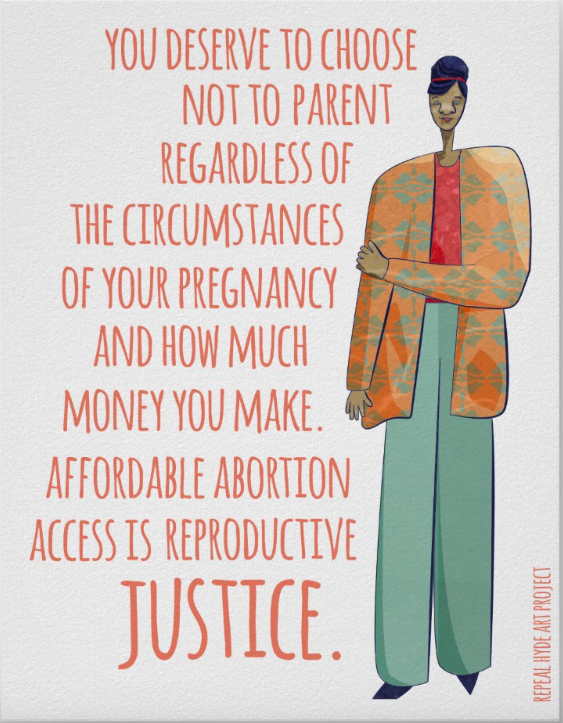
en’s Services, was intentionally painted in bright colors to differentiate it from a medical setting. The logic held up, “Since abortion was not a sickness, the atmosphere associated with hospitals needed to be avoided.” To me, it is easy to draw a parallel to folks with low-risk pregnancies seeking birth center and home birth care in lieu of a hospital, because pregnancy is not an illness.
Because of the clergy’s guidance, this first clinic charged $200 for an abortion when it opened in 1970, and was able to reduce the price to $125 within a year. The quarter of all patients who could not afford the fee were only required to pay $25. This significantly influenced safe, legal abortion care in the United States through today. Although, restrictive court cases continue to come up. A recent example is Whole Woman’s Health v. Hellerstedt, which would have required all abortion clinics to have the facilities of ambulatory surgical centers (thus increasing costs and decreasing access for millions of folks in the already restricted state of Texas). Unfortunately, the future of the supreme court and many decisions about the legality, safety and affordability of reproductive healthcare depend on a highly unpredictable man who has said women should be punished for having an abortion.
Today, a first trimester abortion procedure costs $650. As insurance varies state to state, the future of the Affordable Care Act is in question, and the Hyde Amendment prevents public medicaid funding from covering abortion, abortion funds around the country are trying to make up for the difference. While hospitals continue to provide abortion services (about 4% of them, annually), freestanding clinics like the pink house in Mississippi are making reproductive healthcare as accessible as they can to the communities they serve.
The reality is that the majority of folks who need to access abortion care do not identify as pro-choice. About 38% of folks who have abortions in the US do not identify with a religion. The rest, the majority are Catholic, Protestant, Evangelical or identify with other religious and spiritual groups. Speaking to folks who work in clinics, they often see sidewalk protesters come in for a procedure and go back to protesting the following week. Regardless of how frustrating this may seem, many abortion providers are able to keep doing their work, despite threats of violence and death, restrictive laws, and heartbreaking interactions with patients… because of their faith in God.
Resources
Ministers of a Higher Law by Joshua Wolff, telling the true story of the Clergy Consultation Service on Abortion
Faith Aloud is a compassionate religious and spiritual abortion counseling resource.
Trapped is a documentary about new restrictive abortion laws, prominently featuring Dr. Parker.
For Boston-area folks, First Church Somerville
Ending a Wanted Pregnancy’s compassionate response to harmful, religiously-toned inflammatory comments.
Adoption Is Not a Universal Alternative to Abortion, No Matter What Anti-Choicers Say
Spinning
What’s in my doula bag?
Electric candles – These are something I bring out at almost every hospital birth I attend. With the blue computer/monitor screen glow, many folks are comforted by keeping the room’s lights low and adding the orange-yellow flickering of a few electric candles.
Rebozo – A rebozo is a woven Mexican shawl that can be used to support someone in labor. It is a tool that can wiggle baby into an optimal position by gently rocking the hips or belly. It can also be used to assist in squatting/swaying positions, or used ceremonially as a closing in the weeks following the birth.
Honey – Honey is nice for keeping energy up in labor when my clients don’t feel like eating, or can’t hold down food. Hospital air can be especially dry, and when someone is spending many hours intentionally taking deep breaths, honey can soothe a sore throat. It’s handy to melt into some warm water for an electrolyte boost when clients are nauseous or throwing up.
A handheld fan – Especially nice for quelling nausea, or to give breeze to someone who is laboring in a warm tub. Many are comforted by fanning during pushing, especially with cool wash cloths on the neck, chest, or forehead. The fan I happen to keep in my bag was a gift from Burning Man, and that has made a pleasantly distracting story for many clients.
Essential oils – Now, I don’t recommend applying scents directly to anybody in labor (or anybody, ever). Essential oils are very strong extracts and most normal people will have a skin reaction if they’re not applied in a very diluted way. Besides, giving birth and smelling like a sweaty, messy animal is just how a newborn knows they’ve ended up in the right place. That being said, many of my clients are comforted by certain scents (lavender, rose, ‘woodsy’ pine ones, peppermint, orange). Peppermint is especially nice for nausea, lavender for anxiety, and scent is a tool we can use to distract and calm the body from the intense sensations in labor. Most hospitals are have scent-free policies for folks who have allergies or migraines triggered by scents. When offering aromatherapy in labor, I’ve put a drop or two of essential oils in one of my electric candles (so they can easily be brought to and away from someone’s nose), or put a few drops on a cool cloth for the back of the neck.
A quart of nettle infusion – This one’s all for me! I let the boiling kettle be my timer for getting ready to leave the house. When a client calls, day or night, I’m just about ready to leave at a moment’s notice. In the 5-10 minutes I spend getting by things together, I boil a pot of water for two quarts of tea. One nettle infusion I bring to the birth, and one I have ready and waiting for when I arrive home. After several hours, an infusion of nettle leaf is chock full of iron, calcium, vitamin K, and lots of good things my body needs when I’m too busy to eat fresh vegetables for several hours!
Larabars, Epic bars, fresh fruit, Tanka bars, Justin’s nut butter pouches, dulse – Having autoimmune allergies to most “normal” food, I need to be very mindful of the snacks I bring to keep myself going for my laboring clients. I can’t have any gluten (or most grains), dairy, soy, canola, or foods that are processed on shared equipment with them. That means no take-out, no Whole Foods hot bar, no delivery, no hospital room service, and I could be with a client for up to 30 hours in one stretch. These snacks contain the protein, fat and carbs I need to stay active. (That, and my partner has been known to pull up outside the hospital with something freshly cooked and warm when I’m gone an especially long time!)
Phone charger, toothbrush, deodorant, spare underwear, a book, hair ties/clips, salve/lotion, paper and pens for note taking.
On Being a Queer Doula and Using Gender Neutral Language
As a toLabor trained birth doula, I only recently started listening to the toRaise Doula Podcast, produced by the executive director of the organization, Thérèse Hak-Kuhn, and Richmond Virginia doula, Melanie Headley. Thérèse was actually the woman who facilitated my training in 2010, and hearing her voice brings me right back to my first intensive exposure to birth work! In listening to the recent episodes of the podcast, I realized Thérèse often uses gender neutral language when speaking broadly about pregnancy. She has extensive experiences in working with families, mothers and women in labor, but I wanted to send her a note of appreciation for not excluding everybody else in her choice of language.
Much to my surprise, she wrote back immediately to let me know she was planning on a podcast focused on supporting the LGBTQ community, and admitted she was actively working to be a better ally. She invited me to be on the show to talk about my experience being a queer doula, and to talk about how doulas can best support queer families.
Check out my interview on the August 3rd episode of the toRaise questions doula podcast, #83 How To Support the LGBTQ Client, on Stitcher, libsyn or iTunes! Also take a look at the toLabor website, where they’ve posted a list of resources that we talked about in this episode.
In mentioning the “list of midwives and birth workers who are against using gender neutral language,” I wanted to add a few more details. When Midwives of North America (MANA) announced last year that they were adding gender-neutral language to their core competencies documents, a list of birth workers identified as “Woman-Centered Midwifery” (including Ina May Gaskin herself!) wrote an “Open Letter To MANA,” opposing the use of language to include anybody who is not a cisgender woman. I’d link to their letter or website, but it seems to have since gone absent from the internet! Luckily, Birth for Every Body, a community of queer-friendly birth workers quickly organized to write a response to their letter. Snopes has a little article about how this went down, and how the experiences and opinions of the trans community have been completely misunderstood by much of the midwifery community.
There is a great list of gender and queer parenthood related resources on the Birth for Every Body website.
Herbstalk 2016 Teachers (Saturday, June 4)
Herbstalk 2016 was last weekend in Somerville, MA. The group of Saturday teachers gathered outside the Armory (it was rainy on Sunday), and I participated in my first ever “group jump” photo.
More on the class I taught:
With our culture’s strong focus on birth control and avoiding pregnancy, many people are left in the dark when they actually WANT to become pregnant! With the trend toward older ages for first-time parents (especially around Boston), many are wondering how to prepare their bodies best for parenthood. Why does it seem like everybody has babies so easily while others struggle for years, considering invasive fertility treatments? What does it even feel like to ovulate?
Come learn how to lay the groundwork for healthy fertility cycles, nourish your gametes and give yourself the best chance to have a healthy baby with the help of medicinal herbs and foods. This class is taught from the perspective of a birth doula who has years of experience helping parents (of many ages) have babies around Boston, MA.
